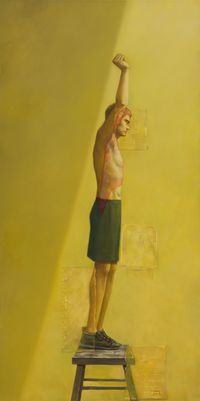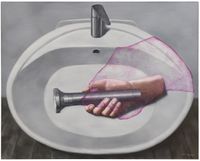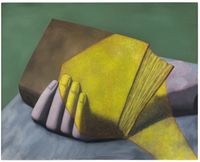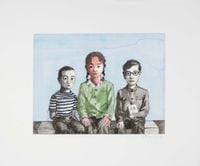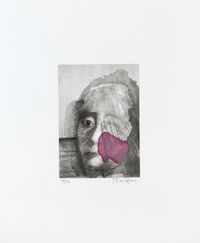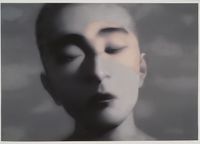Beijing-based contemporary artist Zhang Xiaogang is recognised for his surreal portraits of stylised Chinese figures and his use of symbolism.
Read MoreBorn in Kunming in China's Yunnan province, Zhang Xiaogang grew up during the Cultural Revolution, where his parents were forced to relinquish their government jobs. At age 18, Zhang was sent to a re-education labour camp. After the collapse of the Cultural Revolution, Zhang enrolled at the Sichuan Fine Arts Institute in Chongqing, where he graduated with a BA in oil painting in 1982. He was appointed as a professor at the same institute in 2007.
Zhang's travel to Germany in the early 1990s is often cited as a pivotal point in his practice. As well as visiting museums and galleries, Zhang took time to reflect upon his identity outside of his home country.
Often referencing events and narratives from China's political history, Zhang Xiaogang's works reflect an interrogation of contemporary Chinese identity and the scope of personal and collective memory.
Zhang is best known for his 'Bloodline' series of individual and family portraits, which he began painting in the 1990s. Reminiscent of black-and-white family photographs from the Cultural Revolution period, Zhang's muted oil paintings depict various austere figures with subtly exaggerated features. He seamless blending of tone and edge gives the works a hazy, sepia-tinged appearance, enhancing their dream-like, surreal qualities.
Selected works from the 'Bloodline' series possess an ambivalent satirical edge. My Dream: Little General (2005) depicts a boy wearing military uniform, his lower half unclothed to reveal comically small genitals. A Big Family (1995) presents mother and daughter figures, who frame an unnaturally red-toned male between them.
Other 'Bloodline' works frame extreme close ups of faces—magnifying unsettling glassy-eyed gazes—or headshots reminiscent of passport photos. Whether their vacant expressions are understood as passive, stoic, or conformist, Zhang's anonymous caricatures articulate a uniformity of identity as perceived in the aftermath of the revolution.
Zhang Xiaogang's 'Green Wall' series (2008) is comprised of seven hand-coloured etchings depicting various disquieting interiors in snapshot-like compositions, mostly devoid of human presence. Each interior features a green wall, a common feature of both public and private spaces in 1960s and 70s China, evoking an ambiguous sense of nostalgia, clouded by the anxieties of the present.
Zhang has revisited the 1989 events at Tiananmen Square multiple times in his career. Early works such as Nightmare Series No. 1 (1989) and Lost Dream: Man with a Crown of Thorns (1989) show images of dismembered bodies in nightmarish compositions that reveal influences from Surrealism and Cubism.
Later works such as 'Tiananmen Square' (1993) and the seven silkscreened editions of the 'Tian'anmen Series' (2007) depict the Tiananmen gate amidst the empty square. In an interview with ArtAsiaPacific, Zhang recognises the significance of Tiananmen in his life and practice—marking a more outward, political turn in his artworks. Deliberately absent of human presence, Zhang's Tiananmen works can be seen to reflect the trauma of China's collective consciousness, the tensions between state and individual, and the erasure and rewriting of memory.
Zhang Xiaogang has also worked in collage, sculpture, and installation. His sculptures often serve as extensions of his 'Bloodline' paintings, as illustrated in the cast bronze statues of children in military uniform in My Ideal (2008).
Zhang Xiaogang has exhibited in hundreds of international exhibitions, fairs, and events since 1989.
Select solo exhibitions include Memory +ing, Daegu Art Museum, Korea (2014); Zhang Xiaogang's Oil on Paper, Pace Gallery, Hong Kong (2014); Zhang Xiaogang, Pace Gallery, New York (2013); 16:9, Today Art Museum, Beijing (2010); The China Project: Zhang Xiaogang — Shadows in the Soul, Queensland Art Gallery & Gallery of Modern Art (QAGOMA), Brisbane (2009).
Select group exhibitions include Icons & Vandals, West Chelsea Contemporary, Austin (2021); Racket of Cobwebs: Chinese Contemporary Art Group Exhibition, Tang Contemporary Art, Hong Kong (2020); Contemporary Asian Art, Upsilon Gallery (2020); Fuck Off Generation: Chinese Art in the Post-Mao Era Part II, Ethan Cohen Gallery, New York (2018); Made in Asia, Opera Gallery, New York (2018); A New Dynasty — Created in China, ARoS Aarhus Art Museum, Denmark (2015); Studio, Qiao Space, Shanghai (2016); Installment 4: Chinese Artists at the Fondation Louis Vuitton, Paris (2016); Voyage and Awakening, Fukuoka Asian Art Museum (2013).
His work has also been included in significant events including the Shanghai Biennale (2004); Guangzhou Triennial (2002); the 3rd Gwangju Biennale (2000); and the Venice Biennale (2009, 1995).
Zhang Xiaogang's works are held in collections worldwide, including the Fukuoka Museum of Art; Shanghai Museum; National Museum of Modern and Contemporary Art, Seoul; San Francisco Museum of Modern Art; National Gallery of Australia, Canberra; Art Gallery of New South Wales, Sydney; Solomon R. Guggenheim Museum, New York; University of Southern California Pacific Art Museum, Pasadena; and the Musée de Picardie, Amiens.
Misong Kim | Ocula | 2021
